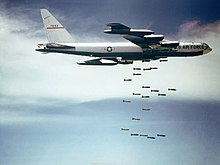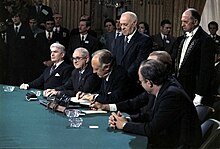North Vietnam
|
Việt Nam Dân Chủ Cộng Hòa Democratic Republic of Vietnam 1945–1976 |
||||||||||
|
||||||||||
| Flag story | ||||||||||
|
||||||||||
| Official language | Vietnamese | |||||||||
| Capital | Hanoi | |||||||||
| Head of state | Ton Duc Thang | |||||||||
| prime minister | Pham Van Dong | |||||||||
| surface | 158,750 km² | |||||||||
| population | 22,480,000 (1973) | |||||||||
| Population density | 142 inhabitants per km² | |||||||||
| GDP per capita | $ 100 | |||||||||
|
Independence - Declared - Recognized - Dissolved |
of France September 2, 1945 1954 July 2, 1976 |
|||||||||
| currency | Đồng | |||||||||
| Time zone | UTC +7 | |||||||||
| National anthem | Tiến Quân Ca | |||||||||

|
||||||||||
The Democratic Republic of Vietnam ( Vietnamese Việt Nam Dân Chủ Cộng Hòa ; abbreviated DRV ), colloquially known as North Vietnam since 1954 , was a state in Southeast Asia on the South China Sea . It was proclaimed on September 1, 1945 by Ho Chi Minh in Hanoi as part of the Union française after the Vietminh (League for the Independence of Vietnam) had conquered power across the country and the Vietnamese Emperor Bảo Đại had abdicated. Until 1947 this state comprised all of Vietnam ; then French colonial troops overthrew Ho's government in Hanoi.
After the victory of the Viet Minh in Điện Biên Phủ in 1954, an independent state of North Vietnam was formed from parts of Bắc Bộs ( Tonkin ) and An Nams ( Annam ) under the leadership of Ho Chi Minh with the capital Hanoi. After the Indochina Conference in 1954, Vietnam was divided into a northern zone, the Democratic Republic of Vietnam , and a formally independent southern zone, from which the state of South Vietnam developed in 1956 . The split was only overcome after the army of North Vietnam conquered South Vietnam in the Vietnam War in 1975. This was followed on July 2, 1976 by reunification to form the “Socialist Republic of Vietnam”.
history
See also → History of Vietnam
independence
On September 2, 1945, after the successful August Revolution , Ho Chi Minh proclaimed the first independent republic of Southeast Asia, the Democratic Republic of Vietnam . The French, who have since returned, initially recognized Vietnam as an autonomous state within the Union Française. The Declaration of Independence was based on the US Declaration of Independence of 1776 and the Declaration of Human and Civil Rights after the French Revolution .
According to an agreement between the Allies during the Potsdam Conference in August 1945, however, the young state was facing occupation by Kuomintang troops from the north and the United Kingdom from the south in order to disarm the Japanese armed forces . However, the British asked the defeated Japanese to restore order in the south. Despite a peace treaty with the Viet Minh, the French, whose troops followed the British, forced the re-establishment of their rule in South Vietnam on September 23, 1945.
War in Indochina and partition of Vietnam
The attempt - in the opinion of some politicians in France - to have to subjugate independent Vietnam again (" bot like ") led to the outbreak of the Indochina War in 1946 . In 1945 there was no longer any question of a complete end to French colonial policy, as could be foreseen in a speech by Charles de Gaulle in Brazzaville in 1942 .
After initial military successes in 1947, the French, who had underestimated the combat strength of the Việt Minh Organization, decided to withdraw due to the lack of soldiers in fortifications along the major roads in northern Vietnam. After a two-year-long stalemate had the Việt Minh army also because of relief supplies from communist China so far strengthened that she was able, the colonial power in the years 1950 to 1953, almost entirely from the North Vietnamese part of the country Tonkin to to evict.
The DRV was formally recognized as the government of a sovereign state by the People's Republic of China and the Soviet Union in January 1950 . The satellite states of the Soviet Union followed the decision in the following weeks.
After years of guerrilla warfare, the Việt Minh under General Võ Nguyên Giáp succeeded on May 7, 1954 in defeating the French troops in the Battle of Điện Biên Phủ . This event marks the end of French colonial rule in Indochina . This was followed by an armistice and a declaration at the subsequent Geneva Indochina Conference of July 21, 1954, which, among other things, until the all-Vietnamese elections to be held in July 1956, a temporary division along a demarcation line at the 17th parallel north of the old imperial city of Huế , provided in a northern and southern zone. In the south, the Quốc gia Việt Nam , founded in 1949, continued to exist as a southern state , whose head of state was initially the former emperor Bảo Đại. As early as 1955, contrary to the Geneva resolution, separate elections were held in the south, which Ngô Đình Diệm won. As a result, he became president, which in fact became the basis for the division of the country, since the planned all-Vietnamese polls never came about.
The US refused to accept the decision of the Geneva conference, but stated in a separate protocol that it would not change the declaration through threats or military force. However, after 1962, the US president sent several thousand so-called military advisers to southern Vietnam in violation of the Geneva Agreement.
Domestic and economic policy
After the victory in the Indochina War, the Communist Party devoted itself to rebuilding the state and society on the model of the Soviet Union . The party controlled the political and personal life of the population through mass organizations. Both handicrafts, industry and agriculture were to be converted into a socialist planned economy through nationalization and collectivization . In 1957 72% of economic output was in private hands, by 1970 91% of the economy had been transferred to the state sector.
Vietnam war and reunification
On August 2nd and 4th, 1964, the incident occurred in the Gulf of Tonkin . After US military advisers were stationed in South Vietnam under President John F. Kennedy , the US took this incident as a reason for massive military build-up. At that time, the USA assumed that the infiltration of North Vietnamese, i.e. communist forces, could overturn the western-oriented South Vietnam and also become communist ( domino theory ). The Soviet Union supported the country with aid payments amounting to 400 million rubles annually and supplied extensive weapons, including tanks, anti-aircraft missiles, modern MiG-21 interceptors , radars and 150,000 tons of fuel and 150,000 tons of grain per month. In April 1966 there were around 500 Soviet military specialists in the country. The People's Republic of China supplied around 250,000 tons of rice in 1966 .
The event in the Gulf of Tonkin marked the beginning of the Vietnam War . From 1965 there was a systematic air war by the United States against North Vietnam. By 1968 the war escalated despite the US military superiority. Around 230,000 partisans and 50,000 members of the official North Vietnamese armed forces fought on the side of the liberation movement FNL (called the Viet Cong by the Americans ) . They faced around 550,000 Americans, roughly the same number of ARVN soldiers , 50,000 South Koreans and smaller contingents of allies (including Australia and New Zealand ).
From 1968 the United States tried more and more to Vietnamize the war . They reduced their direct engagement more and more and prepared the withdrawal of their troops in several steps. The South Vietnamese Army bore the brunt of the war. However, the bombings and air strikes, especially the use of defoliants, by the Americans continued until 1973.
On September 2, 1969, Ho Chi Minh, the president of North Vietnam, died. On January 28, 1973, Henry Kissinger and Lê Đức Thọ , the successor to Ho Chi Minh, agreed an armistice . This ended the direct involvement of the United States in the war, but arms deliveries to South Vietnam continued. The North Vietnamese continued the fight against the south. The People's Liberation Army continued to make profits in South Vietnam . On April 21, 1975, Saigon faced a fall, head of state Nguyễn Văn Thiệu resigned from office, and the last remaining US representatives were evacuated. On April 30th, Saigon was captured and South Vietnam surrendered unconditionally . The Vietnam War was over. On July 2, 1976, North and South Vietnam were reunited under the name Socialist Republic of Vietnam .
See also
literature
- Stanley Karnow: Vietnam, a history . New York, Penguin Books, 1997
- Peter Krebs: The Children of Vietnam. Balance sheet of a modern war . Hamburg 1984, ISBN 3-455-08226-2 , also as dtv vol. 11288, Munich 1990, ISBN 3-423-11288-3
- Peter Scholl-Latour : Death in the rice field: 30 years of war in Indochina . Ullstein, 1981, ISBN 3-548-33022-3
- Nguyễn Khắc Viện: Viet Nam, a Long History . Thế Giới Publishers, Hanoi 1999.
- Marc Frey : History of the Vietnam War. The tragedy in Asia and the end of the American dream . Verlag C. H. Beck, Munich 1998, ISBN 3-406-42078-8
Web links
Individual evidence
- ↑ Colonel James Robinson: The Opening Rounds: 1945. In: Britains Smallwars Britains Smallwars ( Memento of the original from May 17, 2013 in the Internet Archive ) Info: The archive link has been inserted automatically and has not yet been checked. Please check the original and archive link according to the instructions and then remove this notice.
- ^ Ernst Wesenfeld: History of France since 1945. C. H. Beck'sche Verlagsbuchhandlung, Munich 1980. 3rd edition 1996. P. 47.
- ↑ Frederick Logevall: Embers of War - The Fall of an Empire and the Making of America's Vietnam. New York 2013, p. 224.
- ^ Declaration text of the Geneva Indochina Conference 1954 . Publications from Fordham University FU NY New York 2011.
- ↑ US intervention veil of silence. In: Der Spiegel 10/1962 Der Spiegel Spiegel-Verlag, Hamburg 1962.
- ↑ Pierre Brocheux: Histoire du Vietnam contemporain - resilient nation La. Paris 2011, pp. 209-211.



